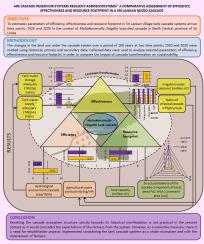Agricultural Systems ( IF 6.1 ) Pub Date : 2022-09-09 , DOI: 10.1016/j.agsy.2022.103493 S. Sirimanna , K.K.P.N. Kahathuduwa , D.V.P. Prasada

|
CONTEXT
Sri Lankan village tank cascades have been classified as a globally important agricultural heritage system (GIAHS) in 2018.Yet, a systematic benchmark of the performance and sustainability of these systems has not taken place to date.
OBJECTIVE
This study assessed the efficiency, effectiveness and resource footprint of village tank cascade systems with a view towards assessing the resilience of the system as a key contributor to the food production in Sri Lanka, by comparing the above parameters in a selected cascade system at two time points.
METHODS
The land uses at two time points, i.e. 1920 and 2020, were studied using historical, primary and secondary data. The study site was Mahakanumulla-Ulagalla village tank cascade located in the dry zone of Sri Lanka. Primary data were collected from the site including social, economic, hydrological and ecological parameters. Landscape mapping was conducted and eight parameters under efficiency, effectiveness and resource footprint were calculated and analyzed using collected data for the two time points to compare the cascade status.
RESULTS AND CONCLUSIONS
The study finds that the structural balance of the cascade system in terms of the ratio between catchment forest, water surface and command area of 5:1:1 has changed to 1:2:1 over a 100 years' period, displaying a clear deterioration. From 1920 to 2020, the agricultural water productivity has increased from 0.65 kg per m3 to 0.81 kg per m3 in the upstream and in the downstream it has increased from 0.65 kg per m3 to 1.00 kg per m3. However, relative to the increase in land productivity (i.e. 2050 kgha−1 to 2962 kgha−1 in the upstream and 2050 kgha−1 to 3009 kgha−1 in the downstream) during the same period, the increase in water productivity has been low. The irrigation water demand has risen from 0.21 million m3 to 0.22 million m3 in the upstream and from 0.28 million m3 to 0.32 million m3 in the downstream. However, the ratio of cascade components has changed causing ecological imbalance in the system with the expansion of home gardens and farm lands.
SIGNIFICANCE
Except for water and land productivity, this study reveals a negative trend in parameters of efficiency, effectiveness and resource footprint between the two time points of comparison, which emphasizes the need for restoring the sustainability. We consider the structural balance and ecological sustainability as key factors in managing and restoring comparable village tank cascade systems. In particular, we highlight that this historically sustainable system may not be able to function sustainably today.
中文翻译:

梯级水库系统是可持续的农业生态系统吗?斯里兰卡微型级联效率、有效性和资源足迹的比较评估
语境
2018 年,斯里兰卡的村庄级联水箱被列为全球重要的农业遗产系统 (GIAHS)。然而,迄今为止,尚未对这些系统的性能和可持续性进行系统基准测试。
客观的
本研究通过两次比较选定级联系统中的上述参数,评估了村庄水箱级联系统的效率、有效性和资源足迹,以评估该系统作为斯里兰卡粮食生产的关键贡献者的弹性点。
方法
对1920 年和2020 年两个时间点的土地利用情况进行了历史、原始和次要数据的研究。研究地点是位于斯里兰卡干旱地区的Mahakanumulla-Ulagalla村水槽梯级。从现场收集的主要数据包括社会、经济、水文和生态参数。进行了景观测绘,并使用收集的两个时间点的数据计算和分析了效率、有效性和资源足迹下的八个参数,以比较级联状态。
结果和结论
研究发现,集水林、水面和指挥区比例为5:1:1的梯级系统结构平衡在100年的时间里已经变为1:2:1,呈现出明显的恶化趋势。 . 从 1920 年到 2020 年,农业用水生产率从上游的 0.65 kg/m 3提高到 0.81 kg/m 3,下游从 0.65 kg/m 3提高到 1.00 kg/m 3。然而,相对于土地生产力的增加(即上游 2050 kgha -1至 2962 kgha -1和 2050 kgha -1至 3009 kgha -1在下游)在同一时期,水生产力的增长一直很低。灌溉需水量从上游的21万米3提高到22万米3 ,下游从28万米3提高到32万米3。然而,随着家庭花园和农田的扩大,梯级成分的比例发生了变化,导致系统生态失衡。
意义
除水和土地生产力外,本研究揭示了两个比较时间点之间效率、有效性和资源足迹参数的负趋势,这强调了恢复可持续性的必要性。我们认为结构平衡和生态可持续性是管理和恢复类似村庄水箱梯级系统的关键因素。特别是,我们强调这个历史上可持续的系统今天可能无法可持续地运作。











































 京公网安备 11010802027423号
京公网安备 11010802027423号